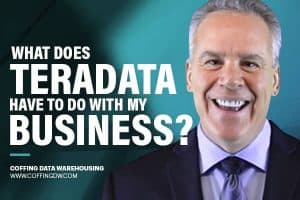What Does Teradata Have to Do with My Business?
 Tera Tom here today to talk about a subject close to my heart – Teradata, of course!
Tera Tom here today to talk about a subject close to my heart – Teradata, of course!
Back in the day, I was a programmer using assembler, COBOL, and C. That gave me the perfect vantage point to learn Teradata from every standpoint: hardware, software, architecture, SQL, and more.
Why was I game to climb such a steep learning curve? Because from the beginning, it was clear that the folks at Teradata had come up with really clever ideas that would lead to breakthrough outcomes. It’s allowed them to dominate the computing world for the last 20 years, after all.
The most important thing they did was solve the Achilles heel of every computing system – the input/output bottleneck between storage and processing. It’s great to have a ton of data sitting out somewhere on a storage device, but you need to get that data into a processor to use it. The more data you need to move, the longer it takes.
Teradata designs systems where instead of pouring all your data into one big processor, you route smaller streams to multiple processors. The flow is faster and the processors work simultaneously on whatever job or query you give them.
It’s like when you’re standing in a long line at the checkout and there’s only one cashier – but then four or five more check stands open. Boom: the line disappears and things get done. Teradata calls the use of multiple processors “parallel processing.”
Parallel Processing
Parallel processing requires a few basic elements. The “brain” behind it is a parsing engine. When you send a request for work into the system, the parsing engine evaluates it. The parsing engine figures out how much data you need and how data tables should flow into each processor. Then, it sends the tables to their processor destinations over bynets.
AMPs
The individual parallel processors are called, “Access Module Processors” (AMPs). They accept the data tables sent to them, process the data, and return results and/or modified data to the parsing engine. The parsing engine returns query results to humans and modified data to storage. Of course, in the real world of big data, things can get a lot more complicated. I’ve done my best to keep them simple here.
How Teradata Helps Business Run Smoother
So, what does all this technology produce in the real world? What are the breakthrough outcomes that keep customers coming back to Teradata?
Teradata for corporations means business success. It’s used by corporations in every industry you can imagine: financial services, healthcare, life sciences, communications, retail, energy, manufacturing, media, and entertainment. As corporations grow and often acquire other organizations, it’s often a huge challenge to integrate disparate computer systems.
These redundant systems each have disk storage containing their own version of the truth, and they don’t talk to each other.
On a corporate level, you don’t know which version of data is closest to the truth, and it’s hugely inefficient to run redundant systems. Teradata makes it possible to bring all your data together in one place and process it efficiently. A single platform allows a transparent view of what’s happening in your corporation. It can also provide end-to-end data lineage, which is critical for regulated industries.
Teradata for corporations means improved accuracy, efficiency, productivity, and compliance.
The benefits of Teradata for executives are a natural outgrowth of data consolidation. Imagine a common global data platform with trustworthy data, consistent data definitions, and best-of-breed analytic capability. Such a platform boosts organizational alignment because different parts of the organization no longer see different data sets. Executives are empowered by such a platform. Finding the information they need to make sound decisions is no longer like looking for a needle in a big-data haystack. No more comparing multiple outdated dashboards to find an answer.
Speed is another benefit of Teradata for executives. A single data source using parallel processing can provide targeted information in real time. Not too much information, not too little. Executives can create queries to search for root cause commonalities. Their understanding and ability to manage challenges such as customer service failures, cost over-runs, and fraud skyrockets. In my Genius Series, I explain Teradata for Executives on a very common sense level, so executives can get just the level of knowledge that they need to make strategic decisions.
Teradata has worked tirelessly to create an easy-to-use platform. Teradata for business users means a world-class user experience on a platform that just plain works. An investment in Teradata, which provides an experience users love, drives fast adoption, utility, and ROI. Check out the Genius Series Teradata for Business Users. It begins with the brilliant Teradata fundamentals before explaining, in more detail, how it works. After reading it, business users will understand Teradata at the exact level they need.
If you’re interested in learning more about what Teradata can do for your business, book me (TeraTom) to come educate your DBAs about Teradata. Also, find my contact information is below. We’d love to hear from you!
Tom Coffing
CEO, Coffing Data Warehousing
Direct: 513 300-0341
Email: Tom.Coffing@CoffingDW.com
Website: www.CoffingDW.com
YouTube channel: CoffingDW
Teradata Training Information

Tom Coffing, better known as Tera-Tom, founded Coffing Data Warehousing, where he has been CEO for the past 30 years. Tom has written over 90 books on Architecture, performance tuning, and SQL on all relevant systems. Tom has taught over 1,000 classes worldwide, and he is the designer of the Nexus, which celebrates 20 years of brilliantly integrating all databases.

